
8345 Results


Define and describe the scientific methodExplain how the scientific method is used in sociological researchUnderstand the function and importance of an interpretive frameworkDefine what reliability and validity mean in a research study
- Subject:
- Social Science
- Sociology
- Material Type:
- Module
- Author:
- OpenStax College
- Date Added:
- 07/18/2021
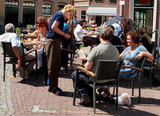
Understand why ethical standards existDemonstrate awareness of the American Sociological Association’s Code of EthicsDefine value neutrality
- Subject:
- Social Science
- Sociology
- Material Type:
- Module
- Author:
- OpenStax College
- Date Added:
- 07/18/2021

Differentiate between four kinds of research methods: surveys, field research, experiments, and secondary data analysisUnderstand why different topics are better suited to different research approaches
- Subject:
- Social Science
- Sociology
- Material Type:
- Module
- Author:
- OpenStax College
- Date Added:
- 07/18/2021
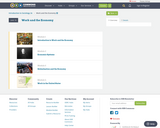
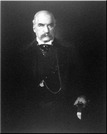
Understand types of economic systems and their historical developmentDescribe capitalism and socialism both in theory and in practiceDiscussion how functionalists, conflict theorists, and symbolic interactionists view the economy and work
- Subject:
- Social Science
- Sociology
- Material Type:
- Module
- Author:
- OpenStax College
- Date Added:
- 07/18/2021

- Subject:
- Social Science
- Sociology
- Material Type:
- Module
- Author:
- OpenStax College
- Date Added:
- 07/18/2021
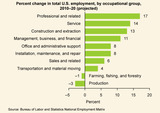
Describe the current U.S. workforce and the trend of polarizationExplain how women and immigrants have changed the modern U.S. workforceUnderstand the basic elements of poverty in the United States today
- Subject:
- Social Science
- Sociology
- Material Type:
- Module
- Author:
- OpenStax College
- Date Added:
- 07/18/2021
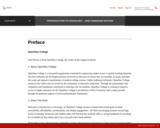
Introduction to Sociology adheres to the scope and sequence of a typical introductory sociology course. In addition to comprehensive coverage of core concepts, foundational scholars, and emerging theories, we have incorporated section reviews with engaging questions, discussions that help students apply the sociological imagination, and features that draw learners into the discipline in meaningful ways. Although this text can be modified and reorganized to suit your needs, the standard version is organized so that topics are introduced conceptually, with relevant, everyday experiences.
- Subject:
- Social Science
- Sociology
- Material Type:
- Textbook
- Provider:
- BCcampus
- Provider Set:
- BCcampus Open Textbooks
- Author:
- Ron McGivern
- William Little
- Date Added:
- 07/07/2021

Studies the major social, political, and aesthetic modes which have shaped Spanish civilization. Coordinates the study of literature, film, art, and architecture with the historical evolution of Spain. Readings and discussions focus on such topics as: the coexistence of Christians, Moors, and Jews; Imperial Spain; The First and Second Republics; and the contemporary period as background for the emergence of distinctively Spanish literary and artistic movements. Taught in Spanish. This course has several purposes. The major concern will be the examination of Spanish culture including Spain's history, architecture, art, literature and film, to determine if there is a uniquely Spanish manner of seeing and understanding the world - one which emerges as clearly distinct from our own and that of other Western European nations.
- Subject:
- Arts and Humanities
- World Cultures
- Material Type:
- Full Course
- Provider:
- M.I.T.
- Provider Set:
- M.I.T. OpenCourseWare
- Author:
- Resnick, Margery
- Date Added:
- 01/01/2004

Offered in the spring and fall terms, Introduction to Stagecraft is a hands-on course that gets students working with the tools and techniques of theatrical production in a practical way. It is not a design course but one devoted to artisanship. Among the many remarkable final projects that have been proposed and presented at the end of the course have been a Renaissance hourglass blown in the MIT glass shop and set into a frame turned on our set shop lathe; a four harness loom built by a student who then wove cloth on it; a number of chain mail tunics and coifs; a wide variety of costume and furniture pieces and electrified period lighting fixtures.
- Subject:
- Arts and Humanities
- Performing Arts
- Material Type:
- Full Course
- Provider:
- M.I.T.
- Provider Set:
- M.I.T. OpenCourseWare
- Author:
- Brown, Sara
- Held, Leslie Cocuzzo
- Katz, Michael
- Perlow, Karen
- Date Added:
- 01/01/2009
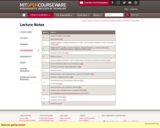
This course is a self-contained introduction to statistics with economic applications. Elements of probability theory, sampling theory, statistical estimation, regression analysis, and hypothesis testing. It uses elementary econometrics and other applications of statistical tools to economic data. It also provides a solid foundation in probability and statistics for economists and other social scientists.
- Subject:
- Economics
- Mathematics
- Social Science
- Material Type:
- Full Course
- Provider:
- M.I.T.
- Provider Set:
- M.I.T. OpenCourseWare
- Author:
- Sara Ellison
- Date Added:
- 07/06/2021
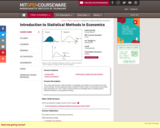
This course will provide a solid foundation in probability and statistics for economists and other social scientists. We will emphasize topics needed for further study of econometrics and provide basic preparation for 14.32. Topics include elements of probability theory, sampling theory, statistical estimation, and hypothesis testing.
- Subject:
- Business and Communication
- Economics
- Mathematics
- Social Science
- Statistics and Probability
- Material Type:
- Full Course
- Provider:
- M.I.T.
- Provider Set:
- M.I.T. OpenCourseWare
- Author:
- Menzel, Konrad
- Date Added:
- 01/01/2009

Introduction to Statistics is a resource for learning and teaching introductory statistics. This work is in the public domain. Therefore, it can be copied and reproduced without limitation. However, we would appreciate a citation where possible. Please cite as: Online Statistics Education: A Multimedia Course of Study (http://onlinestatbook.com/). Project Leader: David M. Lane, Rice University. Instructor's manual, PowerPoint Slides, and additional questions are available.
- Subject:
- Mathematics
- Statistics and Probability
- Material Type:
- Textbook
- Author:
- David Lane
- Date Added:
- 07/07/2021

The main goal of the course is to highlight the general assumptions and methods that underlie all statistical analysis. The purpose is to get a good understanding of the scope, and the limitations of these methods. We also want to learn as much as possible about the assumptions behind the most common methods, in order to evaluate if they apply with reasonable accuracy to a given situation. Our goal is not so much learning bread and butter techniques: these are pre-programmed in widely available and used software, so much so that a mechanical acquisition of these techniques could be quickly done "on the job". What is more challenging is the evaluation of what the results of a statistical procedure really mean, how reliable they are in given circumstances, and what their limitations are.Login: guest_oclPassword: ocl
- Subject:
- Mathematics
- Statistics and Probability
- Material Type:
- Full Course
- Homework/Assignment
- Lecture Notes
- Lesson Plan
- Syllabus
- Provider:
- Washington State Board for Community & Technical Colleges
- Provider Set:
- Open Course Library
- Date Added:
- 10/31/2011
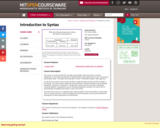
Introduction to theories of syntax underlying work currently being done within the lexical-functional and government-binding frameworks. Organized into three interrelated parts, each focused upon a particular area of concern: phrase structure; the lexicon; and principles and parameters. Grammatical rules and processes constitute a focus of attention throughout the course that serve to reveal both modular structure of grammar and interaction of grammatical components. This course is concerned with the concepts and principles which have been of central significance in the recent development of syntactic theory, with special focus on the "Government and Binding" (GB) / "Principles and Parameters" (P&P) / "Minimalist Program" (MP) approach. It is the first of a series of two courses (24.951 is taught during the Fall and 24.952 is taught in the Spring). This course deals mostly with phrase structure, argument structure and its syntactic expression, including "A-movement". Though other issues (e.g. wh-movement, antecedent-contained deletion, extraposition) may be mentioned during the semester, the course will not systematically investigate these topics in class until 24.952. The goal of the course is to understand why certain problems have been treated in certain ways. Thus, on many occasions a variety of approaches will be discussed, and the (recent) historical development of these approaches are emphasized.
- Subject:
- Arts and Humanities
- Linguistics
- Social Science
- Material Type:
- Full Course
- Provider:
- M.I.T.
- Provider Set:
- M.I.T. OpenCourseWare
- Author:
- DeGraff, Michel
- Date Added:
- 01/01/2003
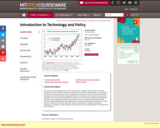
Frameworks and Models for Technology and Policy students explore perspectives in the policy process -- agenda setting, problem definition, framing the terms of debate, formulation and analysis of options, implementation and evaluation of policy outcomes using frameworks including economics and markets, law, and business and management. Methods include cost/benefit analysis, probabilistic risk assessment, and system dynamics. Exercises for Technology and Policy students include developing skills to work on the interface between technology and societal issues; simulation exercises; case studies; and group projects that illustrate issues involving multiple stakeholders with different value structures, high levels of uncertainty, multiple levels of complexity; and value trade-offs that are characteristic of engineering systems. Emphasis on negotiation, team building and group dynamics, and management of multiple actors and leadership. This course explores perspectives in the policy process - agenda setting, problem definition, framing the terms of debate, formulation and analysis of options, implementation and evaluation of policy outcomes using frameworks including economics and markets, law, and business and management. Methods include cost/benefit analysis, probabilistic risk assessment, and system dynamics. Exercises include developing skills to work on the interface between technology and societal issues; simulation exercises; case studies; and group projects that illustrate issues involving multiple stakeholders with different value structures, high levels of uncertainty, multiple levels of complexity; and value trade-offs that are characteristic of engineering systems. Emphasis on negotiation, team building and group dynamics, and management of multiple actors and leadership.
- Subject:
- Applied Science
- Engineering
- Material Type:
- Full Course
- Provider:
- M.I.T.
- Provider Set:
- M.I.T. OpenCourseWare
- Author:
- Weigel, Annalisa
- Date Added:
- 01/01/2006

Introduces topology, covering topics fundamental to modern analysis and geometry. Topological spaces and continuous functions, connectedness, compactness, separation axioms, and selected further topics such as function spaces, metrization theorems, embedding theorems, the Tychonoff theorem.
- Subject:
- Mathematics
- Material Type:
- Full Course
- Provider:
- M.I.T.
- Provider Set:
- M.I.T. OpenCourseWare
- Author:
- Munkres, James
- Date Added:
- 01/01/2004
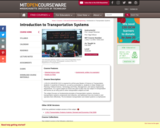
1.201J/11.545J/ESD.210J is required for all first-year Master of Science in Transportation students. It would be of interest to, as well as accessible to, students in Urban Studies and Planning, Political Science, Technology and Policy, Management, and various engineering departments. It is a good subject for those who plan to take only one subject in transportation and serves as an entry point to other transportation subjects as well. The subject focuses on fundamental principles of transportation systems, introduces transportation systems components and networks, and addresses how one invests in and operates them effectively. The tie between transportation and related systems is emphasized.
- Subject:
- Applied Science
- Environmental Science
- Material Type:
- Full Course
- Provider:
- M.I.T.
- Provider Set:
- M.I.T. OpenCourseWare
- Author:
- Sussman, Joseph
- Date Added:
- 01/01/2006
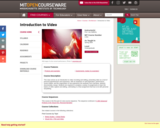
Introduction to video editing and interface devices. Explores video as an environmental, editorial and narrative form. Looks at issues of interpretation, meaning, expression and how they relate to historical, social, and cultural issues.
- Subject:
- Applied Science
- Architecture and Design
- Material Type:
- Full Course
- Provider:
- M.I.T.
- Provider Set:
- M.I.T. OpenCourseWare
- Author:
- Gibbons, Joe
- Date Added:
- 01/01/2004